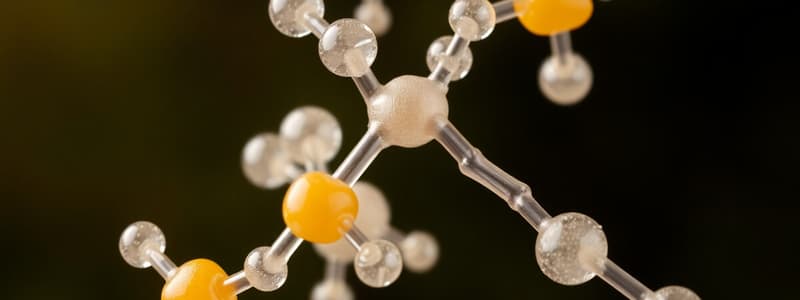Podcast
Questions and Answers
What does the hydrolysis of sucrose by dilute acids or sucrase yield?
What does the hydrolysis of sucrose by dilute acids or sucrase yield?
- Glucose and sucrose
- Galactose and lactose
- Fructose and galactose
- Glucose and fructose (correct)
Which of the following is a characteristic of lactose?
Which of the following is a characteristic of lactose?
- It contains a ẞ-(1,4) galactosidic linkage (correct)
- It can reduce Fehling and Benedict solutions (correct)
- It does not have a free aldehyde group
- It is highly fermentable by yeast
Why is lactose considered a perfect sugar for babies?
Why is lactose considered a perfect sugar for babies?
- It induces gas formation
- It is easily fermented in the stomach
- It is a natural source of galactose (correct)
- It has a high sweetness level
Maltose is formed by which type of linkage between two molecules of glucose?
Maltose is formed by which type of linkage between two molecules of glucose?
Which property is true for maltose?
Which property is true for maltose?
Which monosaccharide is a pentose and classified as an aldose?
Which monosaccharide is a pentose and classified as an aldose?
What is the main blood sugar that tissues utilize?
What is the main blood sugar that tissues utilize?
Which compound has no asymmetric carbon atom?
Which compound has no asymmetric carbon atom?
Which disaccharide is formed from galactose and glucose?
Which disaccharide is formed from galactose and glucose?
What are carbohydrates primarily composed of?
What are carbohydrates primarily composed of?
Which of the following is a characteristic of monosaccharides?
Which of the following is a characteristic of monosaccharides?
Which of the following statements about ketoses is true?
Which of the following statements about ketoses is true?
What is the primary storage form of energy in animals?
What is the primary storage form of energy in animals?
Which hexose is classified as a keto sugar?
Which hexose is classified as a keto sugar?
Which type of carbohydrate has a rapid rise in blood sugar levels?
Which type of carbohydrate has a rapid rise in blood sugar levels?
What type of isomers differ in spatial configuration of atoms but have the same molecular formula?
What type of isomers differ in spatial configuration of atoms but have the same molecular formula?
How many optical isomers does a hexose with 4 asymmetric carbon atoms have?
How many optical isomers does a hexose with 4 asymmetric carbon atoms have?
What is the general formula for many simple carbohydrates?
What is the general formula for many simple carbohydrates?
Which of the following best describes oligosaccharides?
Which of the following best describes oligosaccharides?
What is a function of carbohydrates in the human body?
What is a function of carbohydrates in the human body?
Which monosaccharide corresponds to the classification for 5 carbon atoms?
Which monosaccharide corresponds to the classification for 5 carbon atoms?
What distinguishes D isomers from L isomers in sugars?
What distinguishes D isomers from L isomers in sugars?
Which statement correctly describes epimerism?
Which statement correctly describes epimerism?
What is an anomer?
What is an anomer?
Which of the following explains mutarotation?
Which of the following explains mutarotation?
What happens in a racemic mixture?
What happens in a racemic mixture?
How do monosaccharides behave in water?
How do monosaccharides behave in water?
What defines an asymmetric carbon atom?
What defines an asymmetric carbon atom?
What is the specific rotation of freshly dissolved β-glucose?
What is the specific rotation of freshly dissolved β-glucose?
What products are formed as a result of alcoholic fermentation?
What products are formed as a result of alcoholic fermentation?
Which of the following is formed by the oxidation of glucose?
Which of the following is formed by the oxidation of glucose?
What is a key characteristic of disaccharides?
What is a key characteristic of disaccharides?
Which of the following statements is true regarding sucrose?
Which of the following statements is true regarding sucrose?
What type of sugar is derived from the reduction of sugars?
What type of sugar is derived from the reduction of sugars?
Which type of disaccharide is maltose?
Which type of disaccharide is maltose?
What happens during the reduction of a carbonyl group?
What happens during the reduction of a carbonyl group?
Which type of acids are formed from the oxidation of aldo-sugars?
Which type of acids are formed from the oxidation of aldo-sugars?
Flashcards
Monosaccharides
Monosaccharides
Simple sugars that cannot be further broken down into smaller sugars.
Disaccharides
Disaccharides
Carbohydrates formed by the combination of two monosaccharides.
Oligosaccharides
Oligosaccharides
Carbohydrates composed of 3 to 10 monosaccharide units.
Polysaccharides
Polysaccharides
Signup and view all the flashcards
Glycosidic bond
Glycosidic bond
Signup and view all the flashcards
Carbohydrate formula
Carbohydrate formula
Signup and view all the flashcards
Carbohydrate function
Carbohydrate function
Signup and view all the flashcards
Simple Carbohydrates
Simple Carbohydrates
Signup and view all the flashcards
Optical Isomerism
Optical Isomerism
Signup and view all the flashcards
Asymmetric Carbon Atom
Asymmetric Carbon Atom
Signup and view all the flashcards
Isomers
Isomers
Signup and view all the flashcards
D-isomer
D-isomer
Signup and view all the flashcards
L-isomer
L-isomer
Signup and view all the flashcards
Stereoisomers
Stereoisomers
Signup and view all the flashcards
Enantiomers
Enantiomers
Signup and view all the flashcards
Optical Isomerism
Optical Isomerism
Signup and view all the flashcards
Ketose-Aldose Isomerism
Ketose-Aldose Isomerism
Signup and view all the flashcards
Diastereomers
Diastereomers
Signup and view all the flashcards
Epimers
Epimers
Signup and view all the flashcards
Epimerism
Epimerism
Signup and view all the flashcards
Mutarotation
Mutarotation
Signup and view all the flashcards
Anomerism
Anomerism
Signup and view all the flashcards
Racemic mixture
Racemic mixture
Signup and view all the flashcards
Number of Optical Isomers
Number of Optical Isomers
Signup and view all the flashcards
Invert Sugar Hydrolysis
Invert Sugar Hydrolysis
Signup and view all the flashcards
Lactose Composition
Lactose Composition
Signup and view all the flashcards
Lactose in Baby Formula
Lactose in Baby Formula
Signup and view all the flashcards
Maltose Structure
Maltose Structure
Signup and view all the flashcards
Maltose Properties
Maltose Properties
Signup and view all the flashcards
Alcoholic Fermentation
Alcoholic Fermentation
Signup and view all the flashcards
Esterification (with phosphoric acid)
Esterification (with phosphoric acid)
Signup and view all the flashcards
Oxidation of Primary Alcohol (to Uronic Acid)
Oxidation of Primary Alcohol (to Uronic Acid)
Signup and view all the flashcards
Free Carbonyl Group Reduction
Free Carbonyl Group Reduction
Signup and view all the flashcards
Reducing Properties of Sugars
Reducing Properties of Sugars
Signup and view all the flashcards
Oxidation of Aldo-sugars
Oxidation of Aldo-sugars
Signup and view all the flashcards
Disaccharides Composition
Disaccharides Composition
Signup and view all the flashcards
Sucrose Properties
Sucrose Properties
Signup and view all the flashcards
Study Notes
Carbohydrate Chemistry
- Carbohydrates are polyhydroxyaldehydes or ketones
- They are classified into monosaccharides, oligosaccharides, and polysaccharides
- They are held together by glycosidic bonds
- They provide energy and serve as structural components
Carbohydrate Properties
- Chemically, carbohydrates contain carbon, hydrogen, and oxygen
- The general formula is [CH₂O]n (mostly hydrate of carbon as the ratio of hydrogen to oxygen 2:1) where n is the number of carbon atoms, typically 3 to 8
- Carbohydrates are found in grains, vegetables, fruits, milk, and other dairy products
- The term "sugar" is used for carbohydrates that are soluble in water and sweet to taste
- Some carbohydrates are not digestible
- Carbohydrates are a primary energy source (4 kcal/g)
- Storage forms include glycogen in animals and starch in plants
- Structural components include glycosaminoglycans and cellulose
Classification of Carbohydrates
- Monosaccharides: one sugar unit
- Disaccharides: two sugar units
- Oligosaccharides: 3-10 sugar units
- Polysaccharides: more than 10 sugar units
Monosaccharides
- Cannot be further hydrolyzed
- Contain one sugar unit
- Building blocks of all carbohydrates
- Classified according to the number of carbon atoms: Trioses, Tetroses, Pentoses, Hexoses, Heptoses, Nanoses
- Further classified by functional groups: Aldoses (aldehyde group) and Ketoses (ketone group)
- Examples: Glucose, Fructose, Galactose, Ribose, etc.
Monosaccharides: Types
-
Aldoses:
- Glyceraldehyde
- Erythrose
- Ribose
- Xylose
- Arabinose
- Glucose
- Galactose
- Mannose
-
Ketoses:
- Dihydroxyacetone
- Erythrulose
- Ribulose
- Xylulose
- Fructose
Biochemical and Biological Importance of Some Hexoses
- Glucose: Sugar of grape; main blood sugar; principle sugar used by tissues
- Fructose: Found in fruits, honey; sugar of fetal blood; principle sugar of semen
- Galactose: Found in combination with glucose in milk sugar (Lactose); present in tissues as galactolipid and glycoprotein
Isomers
- Compounds with the same molecular formula but different structures
- Constitutional isomers: Differ in functional group arrangement
- Stereoisomers: Differ in spatial arrangement of atoms
- Diastereomers: Non-mirror image isomers
- Epimers: Differ in configuration around only one carbon atom (excluding the carbonyl carbon)
- Anomers: Differ in configuration around the carbonyl carbon after cyclization
- Enantiomers: Mirror image isomers
- Optical isomers: Different spatial arrangements affect the rotation of polarized light
- Diastereomers: Non-mirror image isomers
Optical Isomerism
- D isomers: OH group on the right side of the penultimate carbon (majority of sugars in humans)
- L isomers: OH group on the left side of the penultimate carbon
Diastereomers of Monosaccharides
- C2-Epimer of Glucose: Mannose
- C4-Epimer of Glucose: Galactose
Cyclic Structure of Monosaccharides
- Monosaccharides in solution exist primarily as cyclic structures
- Cyclization creates a new asymmetric carbon atom (anomeric carbon)
- Glucose forms a six-membered ring; Fructose forms a five-membered ring
Mutarotation
- Spontaneous change in the specific rotation of freshly prepared sugar solutions
- Results from interconversion of α and β anomers
- Equilibrium mixture typically has a specific rotation of +52.5° for glucose
Chemical Properties of Monosaccharides
- Reactions with concentrated acids (e.g., H₂SO₄), used for general carbohydrate tests
- Esterification: Formation of esters, important example is phosphorylation (e.g., glucose-6-phosphate)
- Oxidation: Oxidation of the last primary alcoholic group gives uronic acids (e.g., glucuronic acid).
- Reduction: Reduction produces corresponding alcohols (e.g., sorbitol).
- Reducing properties: Reduction of Fehling or Benedict reagent (used to detect glucose in urine)
Disaccharides
- Formed by condensation of two monosaccharides
- Crystalline, water-soluble, and sweet
- Classified by presence/absence of free reducing groups (aldehyde or ketone)
- Examples: Sucrose, Lactose, and Maltose
Sucrose
- Cane/beet sugar
- Formed by condensation of a-D-glucose and β-D-fructose
- Does not contain free reducing groups
- Does not reduce Fehling or Benedict solutions
- Does not undergo mutarotation
Lactose
- Milk sugar
- Formed by condensation of β-D-galactose and a-D-glucose
- Contains free aldehyde group (from glucose) and reduces Fehling/Benedict reagents
- Non-fermentable by yeast
Maltose
- Formed by condensation of two a-D-glucose units
- Contains free aldehyde group (from glucose) and reduces Fehling/Benedict reagents
Isomaltose
- Formed by hydrolysis of starch and glycogen
- a-1, 6-glucosidic linkage
Derived Sugars
- Monosaccharides with unusual structures or not represented by the general formula
- Acid sugars: (by oxidation of sugars)
- Sugar alcohols: (by reduction of sugars)
- Deoxy sugars: (e.g., deoxyribose in DNA)
- Amino sugars: (e.g., glucosamine, galactosamine)
- Glycosides
Studying That Suits You
Use AI to generate personalized quizzes and flashcards to suit your learning preferences.




